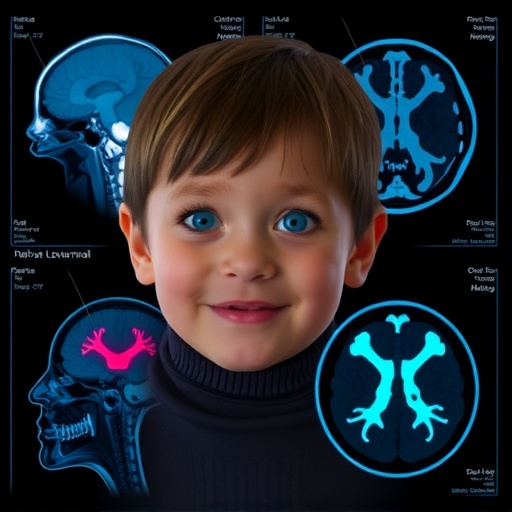In a groundbreaking study, researchers have unveiled critical insights into familial hemophagocytic lymphohistiocytosis (HLH), a rare and severe immune disorder characterized by excessive activation of the immune system. The research, led by Alkaphoury, Mohammad, and Farghal, focuses on the clinical and neuroimaging features associated with this condition, providing a comprehensive overview that may significantly influence diagnosis and treatment strategies.
Familial HLH represents a genetic form of HLH that frequently presents in early childhood, although adult cases have also been documented. Understanding the intricate clinical manifestations of this condition is vital, as it can present with a range of symptoms, from fever and hepatosplenomegaly to cytopenias and neurological deficits. Misdiagnosis can lead to inadequate treatment and dire consequences, making the identification of hallmark clinical features paramount for healthcare professionals.
The importance of neuroimaging in the assessment of patients with familial HLH cannot be overstated. Alterations in brain structure and function can occur due to the relentless immune activation seen in these patients. The study presents compelling data on how various neuroimaging modalities, such as MRI and CT scans, can aid in revealing underlying central nervous system involvement, which is often overlooked in clinical settings. Early detection of neurological complications can lead to timely interventions, improving overall patient outcomes.
Another significant finding from the research highlights the role of genetic testing in confirming the diagnosis of familial HLH. This condition is characterized by mutations in several key genes associated with immunity, including PRF1, UNC13D, and STXBP2. Identifying these genetic anomalies not only solidifies the diagnosis but also provides valuable information regarding the prognosis and potential therapeutic targets. Genetic counseling is advised for families affected by this disorder, ensuring they have a thorough understanding of the implications.
The authors of the study emphasize that family history should not be disregarded during the diagnostic process. A thorough investigation of familial patterns can reveal a predisposition to HLH in siblings or other relatives. This hereditary aspect necessitates a tailored approach to screening and preventive measures in families where genetic factors are at play, which could ultimately lead to better management of the disease.
As the study progresses, the researchers illuminate the therapeutic challenges posed by familial HLH. The standard of care typically includes immunosuppressive therapies, yet they may not be effective for all patients. The explorations into novel treatment regimens are critical to addressing the varied responses observed among patients. Research into targeted therapies, such as those that inhibit specific immune pathways activated in HLH, is gaining momentum and holds promise for better outcomes.
Equally noteworthy is the psychosocial impact that familial HLH inflicts on affected families. The emotional and psychological burden of managing a chronic condition can be overwhelming for both patients and caregivers. Incorporating neuropsychological assessments in the clinical framework is essential, as these evaluations can help identify mental health issues early on, thus providing necessary support systems and resources for families.
Furthermore, public awareness of familial HLH is crucial. The rarity of the condition often leads to a lack of recognition among healthcare providers, resulting in delays in diagnosis. Educating clinicians, particularly in pediatrics and emergency medicine, about the signs and symptoms of HLH could foster earlier detection and treatment initiation, which is vital for improving survival rates.
In addition, ongoing professional education and training programs can enhance knowledge and understanding of familial HLH. The integration of case studies and real-life scenarios in medical training curricula will ensure that future practitioners are well-equipped to identify and manage this complex condition effectively.
Despite the progress made in understanding familial HLH, research is still in its infancy. Larger cohort studies are necessary to validate the findings presented in this study and to elucidate the long-term outcomes of patients diagnosed with the condition. Collaborations between researchers, clinicians, and patient advocacy groups are instrumental in driving forward the research agenda and ensuring comprehensive care.
As the researchers of this pivotal study reflect on their work, they underscore the necessity for continued investigation into the molecular and genetic underpinnings of familial HLH. Insights gleaned from such research not only pave the way for innovative treatment approaches but also contribute to a more profound understanding of immune dysregulation disorders as a whole.
The clinical journey of individuals with familial HLH is fraught with challenges, yet the knowledge gained from recent research endeavors shines a light on a path toward hope and healing. For those diagnosed with this rare condition, the implications of the study are far-reaching, as they may lead to novel interventions and improved quality of life for patients and their families.
In conclusion, the contributions of Alkaphoury and colleagues provide a crucial framework for understanding familial hemophagocytic lymphohistiocytosis. Their findings not only highlight the complexity of this condition but also mark the beginning of a new chapter in research and clinical practice, inspiring future studies to build upon their groundbreaking work.
Subject of Research: Familial Hemophagocytic Lymphohistiocytosis
Article Title: Clinical and Neuroimaging Features of Familial Hemophagocytic Lymphohistiocytosis
Article References:
Alkaphoury, M.G., Mohammad, S.A., Farghal, N.B.E. et al. Clinical and neuroimaging features of familial hemophagocytic lymphohistiocytosis.
Pediatr Radiol (2025). https://doi.org/10.1007/s00247-025-06454-5
Image Credits: AI Generated
DOI: 10.1007/s00247-025-06454-5
Keywords: Familial Hemophagocytic Lymphohistiocytosis, Neuroimaging, Immune Disorder, Genetic Testing, Clinical Features, Treatment Challenges, Psychosocial Impact, Awareness, Research Progress, Diagnostic Criteria.
Tags: clinical manifestations of HLHearly detection of neurological complications in HLHfamilial hemophagocytic lymphohistiocytosisgenetic immune disorders in childrenhepatosplenomegaly in hemophagocytic lymphohistiocytosisimmune system activation in HLHmisdiagnosis of HLHMRI and CT scans for HLHneuroimaging in HLH diagnosisneurological deficits in HLHsymptoms of familial HLHtreatment strategies for HLH





